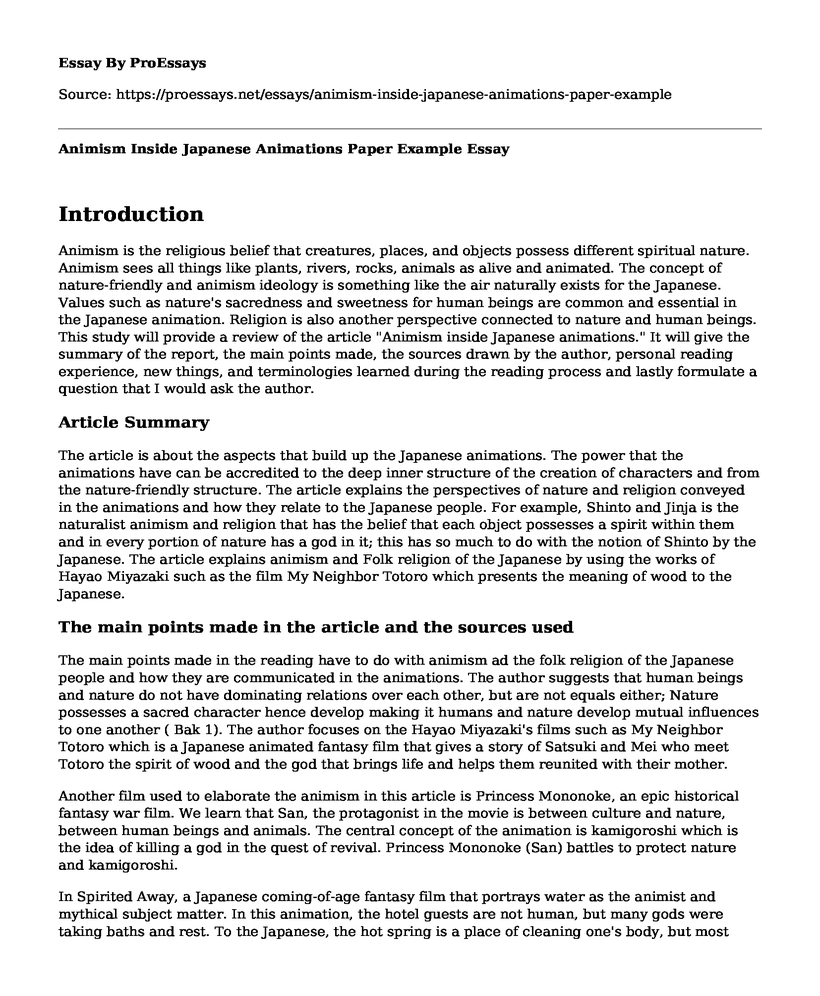Introduction
Animism is the religious belief that creatures, places, and objects possess different spiritual nature. Animism sees all things like plants, rivers, rocks, animals as alive and animated. The concept of nature-friendly and animism ideology is something like the air naturally exists for the Japanese. Values such as nature's sacredness and sweetness for human beings are common and essential in the Japanese animation. Religion is also another perspective connected to nature and human beings. This study will provide a review of the article "Animism inside Japanese animations." It will give the summary of the report, the main points made, the sources drawn by the author, personal reading experience, new things, and terminologies learned during the reading process and lastly formulate a question that I would ask the author.
Article Summary
The article is about the aspects that build up the Japanese animations. The power that the animations have can be accredited to the deep inner structure of the creation of characters and from the nature-friendly structure. The article explains the perspectives of nature and religion conveyed in the animations and how they relate to the Japanese people. For example, Shinto and Jinja is the naturalist animism and religion that has the belief that each object possesses a spirit within them and in every portion of nature has a god in it; this has so much to do with the notion of Shinto by the Japanese. The article explains animism and Folk religion of the Japanese by using the works of Hayao Miyazaki such as the film My Neighbor Totoro which presents the meaning of wood to the Japanese.
The main points made in the article and the sources used
The main points made in the reading have to do with animism ad the folk religion of the Japanese people and how they are communicated in the animations. The author suggests that human beings and nature do not have dominating relations over each other, but are not equals either; Nature possesses a sacred character hence develop making it humans and nature develop mutual influences to one another ( Bak 1). The author focuses on the Hayao Miyazaki's films such as My Neighbor Totoro which is a Japanese animated fantasy film that gives a story of Satsuki and Mei who meet Totoro the spirit of wood and the god that brings life and helps them reunited with their mother.
Another film used to elaborate the animism in this article is Princess Mononoke, an epic historical fantasy war film. We learn that San, the protagonist in the movie is between culture and nature, between human beings and animals. The central concept of the animation is kamigoroshi which is the idea of killing a god in the quest of revival. Princess Mononoke (San) battles to protect nature and kamigoroshi.
In Spirited Away, a Japanese coming-of-age fantasy film that portrays water as the animist and mythical subject matter. In this animation, the hotel guests are not human, but many gods were taking baths and rest. To the Japanese, the hot spring is a place of cleaning one's body, but most importantly, it is a place of a sublime ritual of washing both the body and mind.
Reading experience and the new knowledge acquired
The article is well written, and the illustrations of animism inside Japanese are well done mainly by using Hayao Miyazaki's three films as examples. The arguments are well presented and backed up. I have learned the connections between animism and folk religion of the Japanese and how nature, culture, animals and human beings relate, lastly the use of these factors in animations. My critique would be on the spirits and the underworld, it is interesting to have such stories but I also think that most people don't believe on the concept.
Foreign terms in the article
Foreign terms found in the article are:
- Kamigoroshi- a Japanese concept to kill a god and to look for renewal
- Matsuri- means both a ritual and festival
- Inari- means the growth of rice
- Formulate a question
The question I would have for the author is what he thinks the future would be like, whether people will have the same embrace of animism or not.
Conclusion
The article gives a valid analysis of the Japanese animation and the ideology of the Japanese by illustrating the perspectives of nature and religion conveyed in the animations and how they relate to the Japanese people.
Work Cited
Bak, Mikyung. "Animism inside Japanese animations."
Cite this page
Animism Inside Japanese Animations Paper Example. (2022, Dec 04). Retrieved from https://proessays.net/essays/animism-inside-japanese-animations-paper-example
If you are the original author of this essay and no longer wish to have it published on the ProEssays website, please click below to request its removal:
- Happy Days, Season 1, Episode 1 - All the Way. Movie Review Example.
- Edo Period in Japan Essay Example
- Essay Sample on Facebook Compensation Plans
- Movie Analysis Essay on Watch Rachel Getting Married
- Essay Example on WWI: Trench Propaganda & CPI's Coercive Tactics
- Essay Example on Street Art: Social Messages Through Paint, Yarn and Stickers
- Paper Example on Bringing Historical Publications To Life: Adapting Books Into Films







